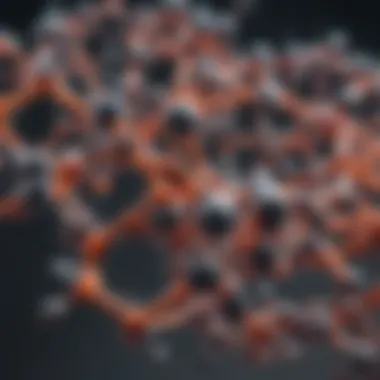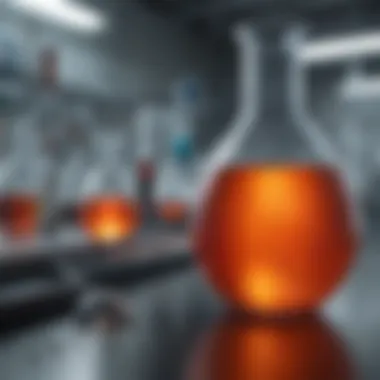Liquid Research Chemicals: Their Role and Impact


Intro
In the realm of scientific exploration, liquid research chemicals serve as essential building blocks for understanding complex phenomena. Their significance stretches across various disciplines, from pharmacology to materials science, marking them as crucial contributors in both academic and practical worlds. Liquid research chemicals are not just substances; they embody a blend of properties, applications, and ethical concerns, forming a diverse ecosystem where innovation is routinely challenged by responsibility.
When delving into these substances, one might ask: What exactly are liquid research chemicals? They are compounds that exist in a liquid state under specified conditions. Their characteristics make them suitable for a myriad of experiments, providing unique insights that solid or gaseous states might not. Whether it’s synthesizing new materials, developing pharmaceuticals, or even pushing the boundaries of nanotechnology, liquid research chemicals are at the forefront of scientific inquiry.
The conversation around these substances is not solely rooted in technical specifications. It also involves a broader discourse on the implications of their use. Concerns about safety, ethical sourcing, and environmental impacts accompany discussions about innovation. Thus, navigating the world of liquid research chemicals requires not only a grasp of their composition and applications but also an understanding of the moral fabric that underpins their usage.
As we explore these themes throughout the article, you are invited to uncover the essential terms and concepts that anchor this discussion, paving the way for deeper insights into the properties, applications, and broader implications of liquid research chemicals.
Prologue to Liquid Research Chemicals
Liquid research chemicals are pivotal in the realms of science and technology, acting as catalysts for innovation and discovery. With their unique compositions and properties, these substances enable researchers to conduct experiments, develop new products, and explore theoretical concepts that push the boundaries of what we know. To fully appreciate the significance of liquid research chemicals, it’s essential to dissect both their definitions and the historical context behind their usage.
Definition and Overview
In essence, liquid research chemicals refer to a broad range of chemical substances that exist in a liquid state at room temperature. These can include solvents, reagents, and intermediates utilized primarily for research purposes. Their liquid form offers distinct advantages, such as enhanced solubility and accessibility for various experimental setups. For instance, consider ethanol. Commonly used as a solvent, it can dissolve a myriad of compounds, making it indispensable in lab settings.
Liquid research chemicals are characterized by their specific chemical structures, which determine their reactivity and interactions with other substances. When employed correctly, they can lead to significant advancements in research across disciplines, from pharmacology to materials science. Moreover, the versatility of these chemicals allows for a variety of applications—from creating new materials to formulating pharmaceuticals that can improve human health.
Historical Context
The usage of liquid chemicals in research dates back centuries. Initially, alchemists experimented with what they could find, often relying on natural liquids like plant extracts or mineral waters. It wasn’t until the Age of Enlightenment that chemical processes became more sophisticated.
The shift from qualitative to quantitative chemistry marked a turning point. Figures such as Antoine Lavoisier began categorizing substances, paving the way for further exploration into liquid chemicals. As industry progressed into the 19th and 20th centuries, synthetic methods emerged. This led to the creation of numerous liquid research chemicals used today.
For example, the development of acetone occurred in the late 19th century. Initially seen as a byproduct of the fermentation process, it found its way into numerous applications, from solvents in the lab to industrial manufacturing.
"The study of liquids in chemistry has always played a central role. They form the backbone of research methodologies across countless fields."
In looking at the historical landscape, one can see a clear evolution of thought and methodology regarding liquid chemicals, reflecting broader trends in scientific inquiry. Understanding this background is crucial for appreciating current practices and optimally leveraging the characteristics of liquid research chemicals today.
Chemical Properties of Liquid Research Chemicals
The realm of liquid research chemicals is as vast as it is intricate. Understanding the chemical properties of these substances provides essential insights into their potential applications and implications. Recognizing their characteristics is critical not just for effective utilization, but also for ensuring safety and compliance within various research environments. This section highlights the specific elements—physical characteristics, chemical behavior, solubility, and stability—that encompass the essence of liquid research chemicals, emphasizing their significance in scientific inquiry and innovation.
Physical Characteristics
The physical characteristics of liquid research chemicals are foundational to their functionality. These attributes include viscosity, density, color, and boiling point. Viscosity, for instance, can dictate how a chemical flows and mixes with other substances. A substance with high viscosity might be sluggish in movement, impacting its application in experiments that require quick reactions or thorough mixing. On the other hand, a low-viscosity liquid behaves quite differently, often allowing for easier dispersal and interaction with other materials.
Density plays a crucial role too. It informs researchers whether a liquid will float or sink when combined with others, further influencing the results of reactions or assays. Furthermore, the color of a chemical can offer immediate visual cues, signalling chemical composition or potential reactions. The boiling point, in turn, determines the conditions under which a substance can safely be heated, impacting both experimental setup and analysis.
The unique interplay of these physical properties not only affects lab procedures but can also be crucial in explaining and predicting chemical behaviors in different environments.
Chemical Behavior
Diving deeper, the chemical behavior of liquid research chemicals encompasses their reactivity, stability, and interaction with other chemicals. The degree to which a liquid chemical reacts with others can dramatically shape experimental outcomes. For instance, some compounds might readily undergo exothermic reactions, releasing heat, while others might be inert under certain conditions, requiring specific triggers to initiate a reaction.


Stability is another key factor to consider. A liquid that is stable under normal conditions may become volatile when subjected to heat, pressure, or exposure to light. This volatility can lead to unsafe situations if not accounted for properly. The use of stabilizers is common to enhance longevity and ensure that the desired properties of a liquid remain intact over time.
Encouraging prudent experimentation, researchers must always carry out compatibility tests, especially when dealing with multiple reagents. Knowing how a liquid behaves chemically in isolation, as well as in diverse mixtures, is paramount for anyone conducting serious research.
Solubility and Stability
Solubility is the cornerstone of many scientific endeavors involving liquid research chemicals. It defines how well a solid or a gas can mix within a liquid, allowing for reactions and interactions to occur. Different liquids exhibit varying solubility profiles, making this characteristic pivotal in applications ranging from pharmaceutical development to agriculture. For example, a water-soluble compound may deliver therapeutic effects more readily than one that requires an organic solvent for absorption.
Stability, once again, cannot be overlooked. A compound might dissolve easily yet remain unstable, potentially leading to degradation over time, particularly under changing conditions like temperature fluctuations or exposure to oxygen. Working with the knowledge of an individual chemical's solubility and stability helps chemists tailor their approach in both experimental design and product formulation. Balancing these two elements ensures that reactions happen efficiently while mitigating risks of failure or hazard.
In summary, the chemical properties of liquid research chemicals—comprising their physical characteristics, chemical behavior, and solubility—play a fundamental role in the ways they can be utilized in research. A comprehensive understanding of these elements is not only a theoretical exercise but is crucial for effective and responsible scientific practice.
Synthesis and Production
The area of synthesis and production of liquid research chemicals stands as a cornerstone of many scientific endeavors. It’s not just about creating substances; it encapsulates the entire spectrum from ideation to practical applications. The processes involved must focus on the intended use of these chemicals, ensuring efficacy while minimizing waste and risks. This section dives into the common methods of synthesis, the essential safety protocols necessary for responsible production, and the quality control measures that guarantee the reliability of the final products.
Common Synthesis Methods
A multitude of synthesis methods exist, each tailored to the specific properties of the chemicals being produced. Some of the most common techniques include:
- Solvent-Solvent Extraction: Utilizes the differing solubility of compounds in various solvents to isolate desired products. This method is efficient but requires careful selection of solvents to minimize toxic waste.
- Distillation: A fundamental technique that separates components based on differences in boiling points. It's widely used in producing pure liquid research chemicals and can be scaled up or down based on needs.
- Refluxing: Involves heating a mixture and allowing vapors to condense back into the liquid. This method ensures reactions occur at higher temperatures without loss of material, allowing for efficient yields.
- Microwave-Assisted Synthesis: An innovative approach that employs microwave energy to enhance reaction rates and yields. It often leads to cleaner reactions and can significantly reduce reaction times.
Each of these methods has its own benefits, tailored toward the specific properties of the target products and intended applications.
Safety Protocols in Chemical Synthesis
Safety in the laboratory is paramount. Working with liquid research chemicals necessitates rigorous protocols to protect researchers and the environment from potential hazards. Proper training for all personnel is an absolute must, which includes understanding Material Safety Data Sheets (MSDS) and emergency procedures. Some key safety protocols include:
- Personal Protective Equipment (PPE): Essential gear such as gloves, goggles, and lab coats should always be worn to guard against splashes and spills.
- Fume Hoods: These are crucial for handling volatile or harmful substances, providing a safe environment for chemical reactions or sample preparation.
- Waste Disposal Procedures: It is necessary to properly categorize and dispose of hazardous chemical waste following local regulations.
- Regular Safety Drills and Training: Keeping everyone alert and prepared for emergencies can significantly reduce risks during unforeseen circumstances.
These practices help in creating a secure atmosphere where research can flourish while minimizing the chances of accidents or hazardous exposures.
Quality Control Measures
Quality control (QC) is a non-negotiable aspect of the synthesis and production process. It ensures that the liquid research chemicals produced meet the required specifications for purity and performance. Here are some common quality control measures:
- Batch Testing: Each production batch should undergo rigorous testing for consistency and purity. Analytical techniques like chromatography often play a key role here.
- Documentation: Maintaining detailed records of synthesis methods, materials used, and testing results ensures traceability and accountability throughout the production process.
- Calibration of Equipment: Regular calibration of analytical equipment ensures that measurements are accurate and reliable.
- Stability Studies: These studies assess how the chemicals behave under various conditions over time, helping in predicting their shelf life and storage needs.
"Quality is not an act, it is a habit." - Aristotle
Implementing these quality control measures provides confidence that the reagents and materials utilized in further research are reliable and of the highest standards. By adhering to these standards, researchers can advance their studies without the concern of compromised materials potentially affecting their results.
Applications in Various Fields
Liquid research chemicals find their stride across numerous disciplines, acting as fundamental components that drive innovation and discovery. Their versatility allows researchers and practitioners to leverage these compounds in ways that can yield significant advancements in technology and health. This section unveils the potential of liquid research chemicals across various fields, shedding light on their unique applications, benefits, and the nuanced considerations that accompany their use.
Pharmaceutical Research
Within the realm of pharmaceutical research, liquid research chemicals serve as the backbone for drug development. These chemicals are integral during the initial stages of pharmaceutical formulation, aiding in the synthesis of active ingredients that can lead to effective medication. The fluid nature of these chemicals facilitates easier reactions and interactions with biological systems, essential for creating therapeutics that can be absorbed effectively by the body.


In addition, the deployment of liquid research chemicals enables researchers to explore diverse therapeutic pathways, encouraging the discovery of novel treatments. Their solubility and reactivity allow for high-throughput screening of drug candidates, dramatically speeding up the discovery process. On the ethical side, careful regulation and testing are paramount to ensure safety and efficacy, as the costs of missteps can be substantial.
Material Science
Shifting the focus, material science harnesses the properties of liquid research chemicals to engineer new materials that are both innovative and functional. Liquid-phase synthesis can produce materials with unique characteristics, such as lightweight composites or advanced polymers. The versatility in properties such as thermal conductivity and tensile strength means researchers can tailor materials for specific applications in industries ranging from aerospace to electronics.
Furthermore, many cutting-edge technologies rely on liquid research chemicals for processes such as thin-film deposition and nanomaterial fabrication. As material science continues to advance, the demand for specialized liquid chemicals will likely grow, emphasizing the importance of maintaining safety and quality control measures.
Environmental Studies
In environmental studies, liquid research chemicals play a critical role in understanding and solving ecological challenges. Their applications span from pollutant detection to the development of sustainable solutions for managing waste and contamination. By using specific reagents in liquid form, scientists can more easily monitor environmental changes and identify hazardous substances in water and soil samples.
Moreover, these chemicals facilitate the development of bioremediation technologies, where they can help restore polluted environments through engineered microbes. The importance of responsible application cannot be overstated; it’s crucial that the environmental impact is carefully assessed to avoid causing further harm.
"Liquid research chemicals are not just tools, they are gateways to understanding complex interactions within the environment."
Agricultural Applications
Lastly, the agricultural sector is reaping the benefits of liquid research chemicals through enhanced growth and pest management strategies. Fertilizers, pesticides, and growth regulators in liquid forms are easier to apply and often yield quicker results than their solid counterparts. They can penetrate the soil and plant structures more efficiently, ensuring better nutrient uptake and pest control.
Liquid formulations allow for precision agriculture techniques, where monitoring and managing crops with chemical inputs become much more targeted. However, careful consideration of environmental and health implications is essential. The use of such chemicals must be aligned with sustainable practices to promote long-term agricultural viability while safeguarding ecosystems.
The impact of liquid research chemicals spans across multiple fields, with each application area presenting its own opportunities and challenges. As the landscape of scientific research evolves, staying aware of the implications of using these powerful agents becomes paramount for responsible growth and discovery.
Ethical Considerations in Liquid Research Chemical Usage
The realm of liquid research chemicals is not only about scientific exploration and discovery. There exists a crucial layer of responsibility when it comes to their usage, and this primarily ties into ethical considerations. The implications of using these chemicals extend beyond the laboratory benches, affecting society, environment, and ultimately, human life. Every step in the journey of liquid research chemicals must consider these ethical dimensions carefully.
Regulatory Framework
Navigating the regulatory landscape surrounding liquid research chemicals can resemble trekking through a dense jungle. Various national and international bodies have established guidelines to govern the production, handling, and distribution of these substances. Regulations vary greatly by region, and understanding them is essential for any researcher involved in liquid chemicals.
For instance, in the United States, the Drug Enforcement Administration (DEA) sets strict regulations for controlled substances, while the Environmental Protection Agency (EPA) monitors chemicals that might pose risks to the environment. Various scientific institutions and universities also hold specific protocols ensuring compliance with safety standards and ethical use. It's crucial for researchers to keep abreast of these regulations to prevent legal ramifications and ensure that their work contributes positively to society.
Risks of Misuse
When one peels back the layers of liquid research chemicals, the risk of misuse stares back. The potential for these chemicals to be misapplied or utilized beyond their intended purpose definitely raises alarms. Some might be tempted to take shortcuts or utilize them for non-scientific applications, leading to outcomes that could endanger public health or environmental safety.
To illustrate, a straightforward case is seen in the abuse of certain chemicals in recreational settings. This misuse morphs the original intentions of research into dangerous territory. Furthermore, the lack of awareness regarding toxicity and potential side effects can result in dire consequences, not only for the individual but also for those around them. Hence, researchers bear a responsibility to communicate these risks clearly and educate others about the beauty of ethics in scientific exploration.
Importance of Responsible Research
Responsible research practices in the domain of liquid research chemicals cannot be overemphasized. They form the bedrock upon which the integrity of scientific inquiry stands. Accountability, transparency, and ethical considerations guide these practices, ensuring that advancements in knowledge do not come at the reckless expense of safety or ethical standards.
Moreover, it forms a pivotal part of establishing trust with the public. As researchers and scientists work diligently to push the boundaries of what is known, they must also remember their role within the broader societal context.
A few principles to underscore responsible research include:
- Transparency: Sharing findings and methodologies openly to allow for scrutiny and replication.
- Integrity: Upholding the truth in research, ensuring data is not manipulated to sway results.
- Education: Continuing to inform peers and the public about the safe and ethical use of chemicals.
- Collaboration: Working together across disciplines to foster an environment of shared learning and respect for ethical standards.


"Science knows no boundaries, but ethics draws the lines that should not be crossed."
The journey into the depth of liquid research chemicals must certainly include a firm commitment to ethical considerations. Balancing innovation with responsibility is the essence of true scientific endeavor. Stakeholders, researchers, and policymakers alike must continually align their practices and philosophies to navigate this complex web with grace and insight.
Future Directions in Liquid Research Chemicals
Future directions in the field of liquid research chemicals are crucial as they shape the landscape of scientific inquiry and development. With an increasing emphasis on innovation, researchers must explore these directions to enhance experimental capabilities. By considering diverse applications and new methodologies, scientists can harness the full potential of these compounds.
Innovative Research Trends
Emerging trends in research are paving the way for liquid research chemicals to become even more versatile. The use of nanotechnology, for instance, is allowing for the formulation of chemical agents with precise functionality. Nanoparticles can enhance the delivery and effectiveness of certain compounds, making them potent tools in fields like drug development and environmental chemistry.
Moreover, interdisciplinary approaches are gaining traction. For example, combining principles from chemistry, biology, and material science is leading to the creation of hybrid chemicals. These hybrids are designed to address specific challenges that often arise in traditional methods, whether that’s in pharmaceuticals or sustainable materials production. Researchers are now increasingly looking at how these cross-disciplinary methods can foster innovation.
Emerging Technologies
Several cutting-edge technologies are emerging in the realm of liquid research chemicals. Automated synthesis systems are becoming widely adopted, significantly increasing efficiency and reducing human error. By utilizing robotics and AI, laboratories can automate repetitive tasks, allowing researchers to focus on more complex analyses and interpretations of data.
Additionally, advancements in chromatography and spectrometry are improving the ways chemicals are separated and analyzed. These technologies provide more precise data about the chemical properties and interactions of liquid research chemicals, which is crucial in understanding how they might behave in various environments.
As a sidebar, biocompatible solvents are making headway in research for pharmaceuticals and biosciences. The move away from traditional solvents, that can be toxic, reflects a growing trend toward safer and more sustainable research practices. This is a clear indicator of the shift towards environmental considerations in chemical research.
Collaborative Research Approaches
Another key aspect of the future landscape involves collaborative research approaches. Increasing partnerships between academia, industry, and regulatory bodies are promoting a more integrated framework for liquid research chemicals. Through these collaborations, researchers can share insights and resources, thereby accelerating the pace of innovation.
Establishing networks that involve diverse stakeholders also brings varied perspectives to the table. This multidisciplinary input can lead to more comprehensive solutions to complex problems that individual disciplines might find challenging to tackle alone.
Moreover, these partnerships could foster responsible research practices. Engaging with regulatory authorities from the outset of research projects ensures that ethical considerations are prioritized, which is vital in maintaining public trust and safety.
The scope for innovation in liquid research chemicals continues to expand, making collaboration essential for responsible progress.
In summary, the future of liquid research chemicals is bright, with promising trends towards innovative methodologies, emerging technologies, and collaborative frameworks. By embracing these directions, researchers can push the boundaries of what’s possible, while keeping ethical standards and responsible practices firmly in mind.
Epilogue
In the realm of liquid research chemicals, understanding the intricacies and implications is crucial for advancing scientific inquiry. This section serves as a capstone to the insights gathered throughout the article, highlighting essential elements that define the importance of these compounds across various fields.
Summary of Key Insights
Liquid research chemicals are not merely substances used in experiments; they embody a spectrum of possibilities. Key insights include:
- Diverse Applications: These substances find utility in pharmaceutical research, material science, environmental studies, and agriculture, showing that their relevance crosses disciplinary boundaries.
- Safety and Ethics: The discourse surrounding the responsible use of these chemicals cannot be overstated. The balance between innovation and safety is a delicate dance that researchers must navigate regularly.
- Synthesis and Control: The synthesis methods and quality control measures are foundational to ensuring that the chemicals are both effective and safe for intended applications.
- Future Innovations: Trends and technological advancements suggest that the exploration of liquid research chemicals will continue to evolve, bringing forth new research potentials and collaborative efforts.
This summary gives a glimpse into how pivotal liquid research chemicals are in scientific development, requiring both understanding and caution.
Final Thoughts on Liquid Research Chemicals
The domain of liquid research chemicals is rich and multifaceted. As science progresses, the importance of these chemicals will likely increase, driven by the demand for innovative solutions to complex problems. Researchers must approach their work with respect and responsibility, ensuring that ethical considerations guide their endeavors. The potential for groundbreaking discoveries is immense, yet with this potential comes the duty to prioritize safety and public welfare.
Ultimately, liquid research chemicals hold a mirror to the spirits of inquiry and responsibility. As we delve deeper into their characteristics and applications, we pave the way for advancements that respect both human and environmental considerations. These chemicals are not just tools; they symbolize the cutting edge of research and the commitment to developing a safer, more profound understanding of the material world around us.
"The journey into the realm of liquid research chemicals is both exciting and daunting; embrace it with care, for the discoveries made within these liquids could change the world."
Maintaining a focus on responsible practices, alongside a pursuit of knowledge, can ensure that the exploration of these chemicals continues to yield fruitful outcomes for society at large.







